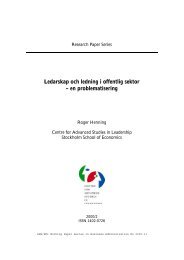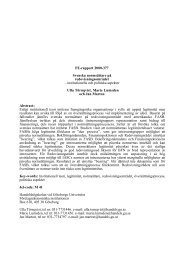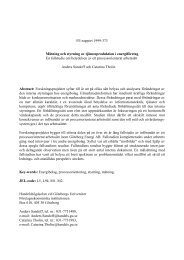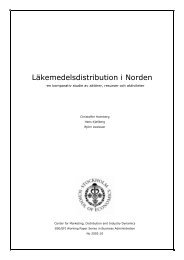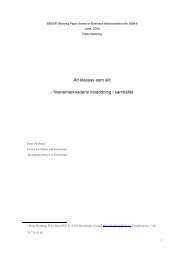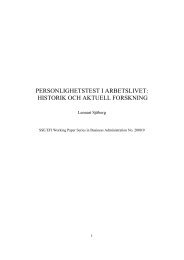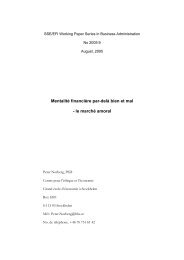Big Five Plus - S-WoBA - Handelshögskolan i Stockholm
Big Five Plus - S-WoBA - Handelshögskolan i Stockholm
Big Five Plus - S-WoBA - Handelshögskolan i Stockholm
You also want an ePaper? Increase the reach of your titles
YUMPU automatically turns print PDFs into web optimized ePapers that Google loves.
299. van Iddekinge, C. H., Raymark, P. H., Eidson, C. E., & Attenweiler, W. J. (2004). What<br />
do structured selection interviews really measure? The construct validity of behavior<br />
description interviews. Human Performance, 17(1), 71-93.<br />
300. Van Rooy, D. L., Alonso, A., & Viswesvaran, C. (2005). Group differences in emotional<br />
intelligence scores: Theoretical and practical implications. Personality and Individual<br />
Differences, 38(3), 689-700.<br />
301. Van Rooy, D. L., & Viswesvaran, C. (2004). Emotional intelligence: A meta-analytic<br />
investigation of predictive validity and nomological net. Journal of Vocational Behavior,<br />
65(1), 71-95.<br />
302. Van Vugt, M., Hogan, R., & Kaiser, R. B. (2008). Leadership, followership, and evolution:<br />
Some lessons from the past. American Psychologist, 63, 182-196.<br />
303. Vasilopoulos, N. L., Cucina, J. M., Dyomina, N. V., Morewitz, C. L., & Reilly, R. R.<br />
(2006). Forced-Choice Personality Tests: A Measure of Personality and Cognitive<br />
Ability? Human Performance, 19, 175-199.<br />
304. Watson, D., Clark, L. A., & Tellegen, A. (1988). Development and validation of brief<br />
measures of positive and negative affect: The PANAS scales. Journal of Personality<br />
and Social Psychology, 54(6), 1063-1070.<br />
305. Webb, E. (1915). Character and Intelligence. British Journal of Psychology, 1(3), 99.<br />
306. Weis, S., & Sűss, H.-M. (2007). Reviving the search for social intelligence - A multitraitmultimethod<br />
study of its structure and construct validity. Personality and Individual<br />
Differences, 42(1), 3-14.<br />
307. Weisberg, R. W. (2006). Creativity. Understanding innovation in problem solving, science,<br />
invention, and the arts. New York: Wiley.<br />
308. Wetzler, S. (1992). Living with the passive-aggressive man. New York: Simon & Schuster.<br />
309. Wiggins, J. S., Trapnell, P. D., & Wiggins, J. S. (1996). A dyadic-interactional perspective<br />
on the five-factor model. In J. S. Wiggins (Ed.), The five-factor model of personality:<br />
Theoretical perspectives (pp. 88-162). New York: Guilford Press.<br />
310. Viswesvaran, C., Schmidt, F. L., & Ones, D. S. (2005). Is There a General Factor in Ratings<br />
of Job Performance? A Meta-Analytic Framework for Disentangling Substantive<br />
and Error Influences. Journal of Applied Psychology, 90(1), 108-131.<br />
311. Vodanovich, S. J. (2003). Psychometric measures of boredom: A review of the literature.<br />
Journal of Psychology: Interdisciplinary and Applied, 137(6), 569-595.<br />
312. Wood, J. M., Nezworski, M. T., Lilienfeld, S. O., & Garb, H. N. (2003). What's wrong<br />
with the Rorschach?: Science confronts the controversial inkblot test. San Francisco,<br />
CA, US: Jossey-Bass.<br />
172



